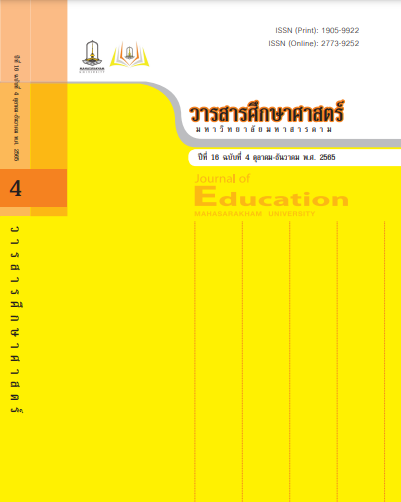Evaluation of the Project to bring the King’s Science to Sustainable Development Philosophy of Sufficiency Economy of Bannongyaplong School under Chaiyaphum Primary Educational Service Area District Office 1
Main Article Content
Abstract
Evaluation has the objectives 1) to assess the project context 2) to assess the import factor on the project 3) to assess the project implementation process 4) to assess the impact of the project 5) to assess the effectiveness of the project 6) to assess the sustainability of the project, and 7) to assess the transfer of the project. The assessment model applied Daniel Stufflebeam’s CIPPIEST assessment model assessed all seven areas. The sample group consisted of qualified persons, school administrators, teachers, and educational personnel, students in grades four-six, and those involved in the project. The academic year 2020 – 2021, a total of 186 people, project evaluation period, the fiscal year 2021. By divided into three phases as follows: 1) pre-project carry out an assessment, 2) an assessment between carrying out a project, and 3) assessment when the end of the project carrying. The evaluation results found that in the context the mean is the most, on the import factor and process the mean is very level, on the impact, it was found that score posttests were significantly higher than pretest significant at the.05 levels. On the effectiveness of the project, it was found that satisfaction with learning management according to the philosophy of sufficiency economy the mean is very level, on the sustainability of the project and the transfer of the project, the mean is at high.
Downloads
Article Details

This work is licensed under a Creative Commons Attribution-NonCommercial-NoDerivatives 4.0 International License.
References
กระทรวงศึกษาธิการ. (2560). แนวทางการดำ เนินงานโครงการสถานศึกษาน้อมนำ ศาสตร์พระราชาสู่การพัฒนาอย่างยั่งยืน ด้านหลักปรัชญาของเศรษฐกิจพอเพียง กระทรวงศึกษาธิการ. กรุงเทพฯ: สำนักส่งเสริมกิจการศึกษา สำนักงานปลัดกระทรวงศึกษาธิการ.
ชารดา จิตต์อำ มาตย์. (2560). การประเมินโครงการสถานศึกษาแบบอย่างการจัด กิจกรรมการเรียนรู้และการบริหารจัดการตามหลักปรัชญาของเศรษฐกิจ (สถานศึกษาพอเพียง) ของโรงเรียนเหล่าฝ้ายผดุงวิทย์ จังหวัดหนองคาย [วิทยานิพนธ์ ค.ม., มหาวิทยาลัยราชภัฎมหาสารคาม, มหาสารคาม].
ณัฐวรรณ แย้มละมัย และสุณี หงส์วิเศษ. (2561). การประเมินผลโครงการส่งเสริมสุขภาพผู้สูงอายุเทศบาลตำ บลตะเคียนเตี้ย อำเภอบางละมุง จังหวัดชลบุรี. วารสารมหาวิทยาลัยนครพนม, 8(3), 17-25.
บุญชม ศรีสะอาด. (2560). การวิจัยเบื้องต้น. พิมพ์ครั้งที่ 10. กรุงเทพฯ: สุวีริยาสาส์น.
มาเรียม นิลพันธ์. (2553). การประเมินหลักสูตรที่เน้นการตัดสินใจโดยใช้วิธีเชิงระบบ โดยในรูปแบบ CIPP Model, รายงานการวิจัย, มหาวิทยาลัยศิลปากร, นครปฐม.
สุปัญญา ชาดง และสิรินาถ จงกลกลาง. (2562). การประเมินหลักสูตรจินตคณิต ของสถาบัน 072 จินตคณิต โดยใช้ CIPPIEST MODEL. วารสารวิชาการศึกษาศาสตร์, 20(1), 116-123.
Intrachim, C. (2017). Science of the King: The philosophy of sufficiency economy. Rajabhat Maha Sarakham University Journal, 11(sp1), 295-308.
Krejcie, R.V. & Morgan, D.W. (1970). Determining sample size for research activities. Educational and Psychological Measurement, 30(3), 607-610.
Stufflebeam, D.L. and Shinkfield, A.J. (2007). Evaluation theory, models & applications. CA: Jossey-Bass.
Tubporn, H. (2017). The King’s philosophy, sufficiency economy: Wisdom of Thailand. Journal of Humanities and Social Sciences Bansomdejchaopraya Rajabhat
University, 11(1), 66-79.


